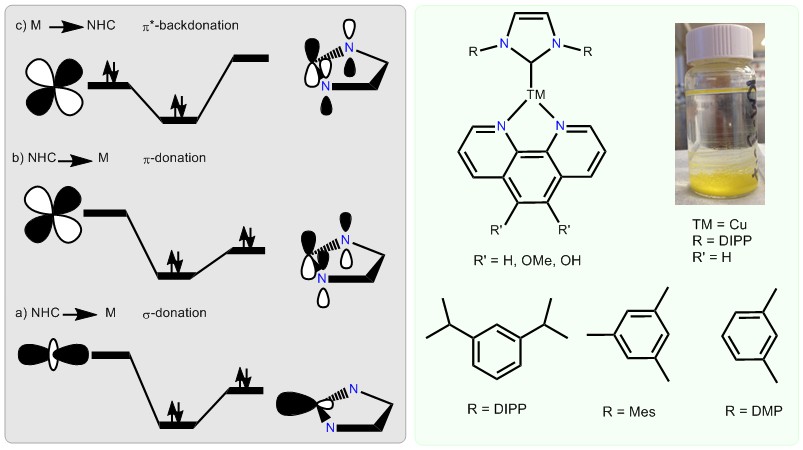TM-NHC complexes containing highly conjugated N-donor ligands are used for photophysical studies.
Photoluminescent TM Complexes of N-Heterocyclic Carbenes (NHCs)
Emission of light that follows the absorption of photons by a species is called photoluminescence. In general and as shown in Figure 1, this phenomenon can take place by two mechanisms: Fluorescence (spin-allowed) and Phosphorescence (spin-forbidden) emission of light from an electronic excited state. Organic and coordination-compound based molecules are among the most popular classes of light-emitting molecules. The versatility of the transition metal-based luminophores which allows them to cover the entire spectrum from blue to NIR has placed them among the most promising agents for development of optical imaging dyes. The potential application of luminescent complexes in optoelectronic devices such as organic light-emitting diodes (OLEDs) and light-emitting electrochemical cells (LEECs) have attracted great attention to their synthesis and photophysical properties.

Figure 1.
TM-NHC Complexes
The two relevant electronic properties of NHC ligands that bears a great impact on their photoelectronic properties are:
(1) strong σ-donation to M which rises up the energy of metal d-d transitions and quenches the nonradiative decay pathways.
(2) weak π-accepting from M which is manifested in their high-energy π* orbitals. This effect not only reduces the internal LC transitions, but also shifts the emissive excited state to a higher energy (blue region) which is of great importance in light-emitting diodes.
In order to prepare efficient light-emitting transition metal complexes, it is vital to regulate the electronic structures (HOMO and LUMO) of the ground and excited states such that the ISC is favored over non-radiative decays, or low-lying d-d transitions. A powerful strategy in this context is utilizing strong-filed multidentate chelating ligands to widen the energy gap between emitting states, which will ultimately deactivate the d-d transitions. The main goal of our research in this area is to develope robust TM-NHC complexes using highly conjugated, chelating ligands that can form room temperature emitters with high quantum yields. We take advantage of strong σ-donating and weak π-accepting properties of NHC ligands to prepare transition metal complexes in a hybrid coordination environment with bi- or tridentate nitrogen- and phosphorous-donor ligands.

